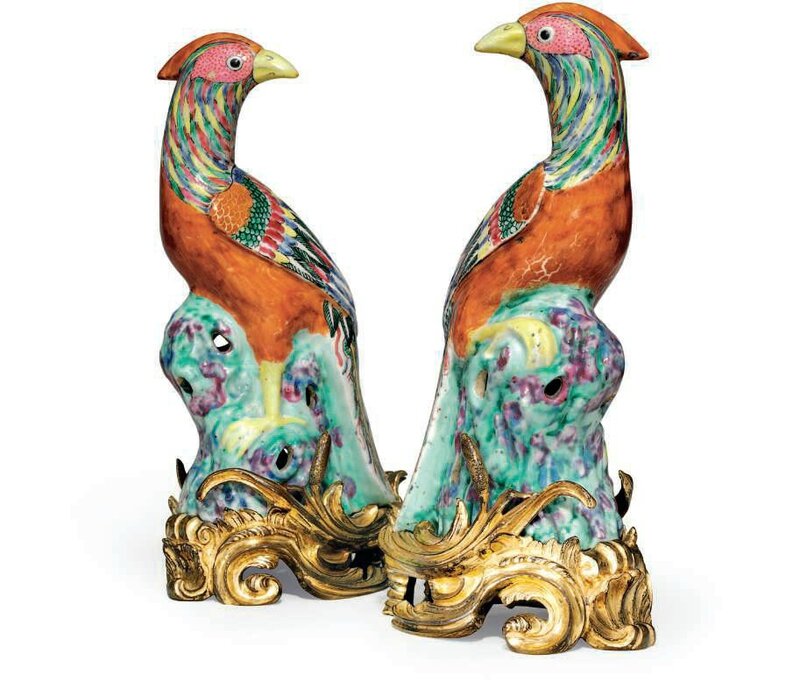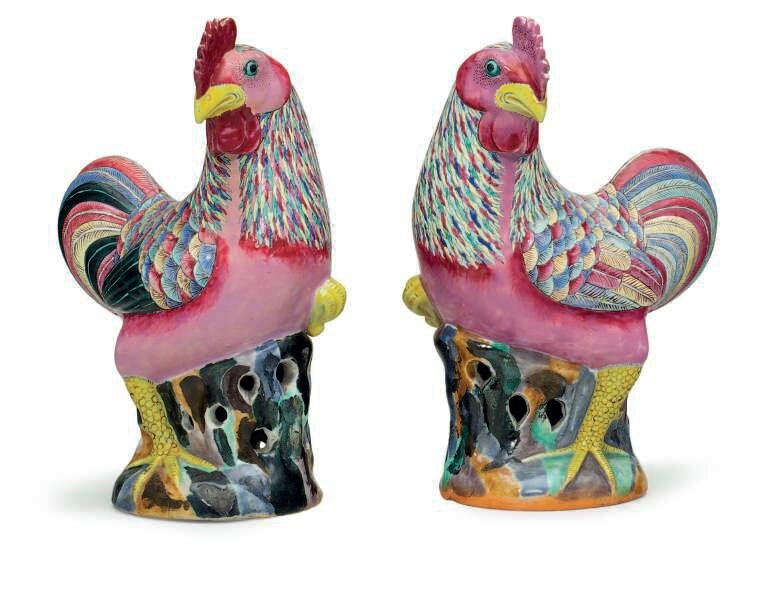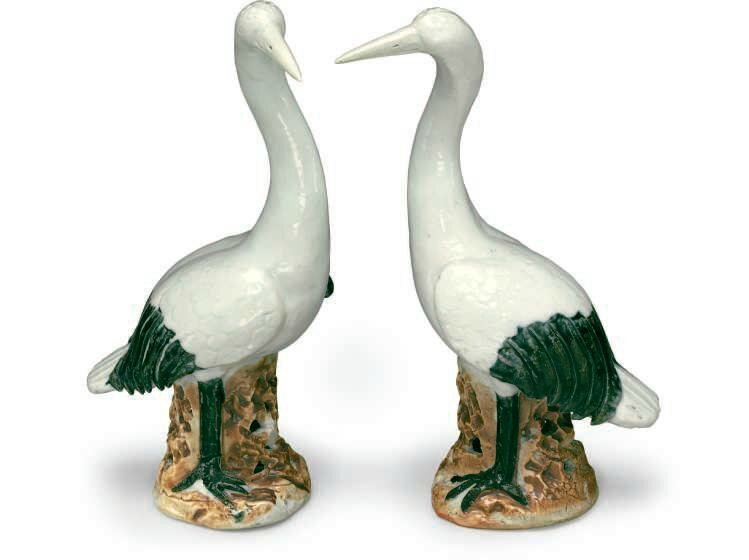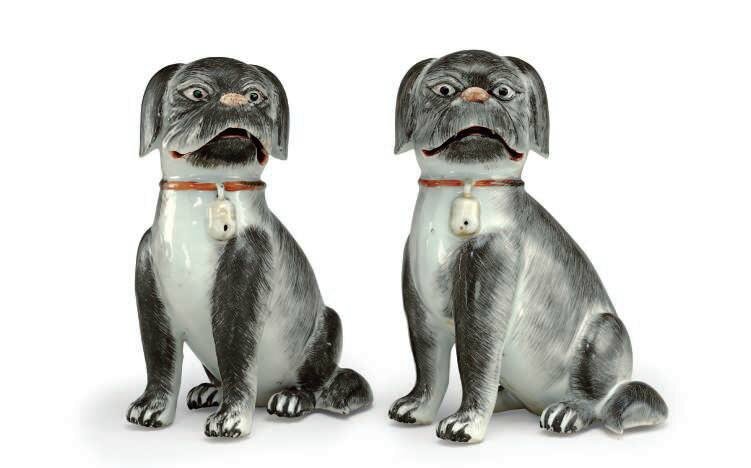MANDARIN & MENAGERIE: The James E. Sowell Collection, Part III, Chinese porcelain
Over a period of twenty years James Sowell slowly assembled the best collection of Chinese porcelain birds, animals and figures in the country. Not only comprehensive, the Sowell Collection features jewels of top quality in each category it encompasses, from important, large pairs of majestic birds, courtiers and exotic animals to charming and colorful figures of laughing boys and courting couples.
The collection resided happily in the Sowells’ Dallas home surrounded by classic English furniture of the Georgian period. In 2008 the export collection was published by Sowell’s dealers and advisors Cohen and Cohen in a lavishly illustrated and researched book, Mandarin and Menagerie.
A thread running through all of the Sowell Collection is stellar provenance. With acquisitions from landmark London and Paris auctions as well as from top European dealers, the Sowell Collection represents the enduring pleasures of the finest works of art.
Lot 43. A famille rose seated courtesan, circa 1785. Estimate $4,000 – $6,000. Photo Christie's Image 2016.
The seated lady holding a gilt vase, her robes floral over iron-red trousers - 8 ¼ in. (21 cm.) high
Literature: M. Cohen and W. Motley, Mandarin and Menagerie, Chinese and Japanese Export Ceramic Figures, Reigate, 2008, p.110, no. 5.12.
Lot 44. A famille rose crane, 18th century. Estimate $4,000 – $6,000. Photo Christie's Image 2016.
Modeled standing beside a flowering tree on an oval base, blue legs and red beak, the plumage of neck and tail feathers enameled in black - 9 in. (23 cm.) high
Provenance: With Luis Alegria, Portugal.
Literature: op. cit., pp. 252, no. 17.5
Lot 45. A pair of rose-verte Buddhist lions, 19th century, possibly Samson. Estimate $12,000 – $18,000. Photo Christie's Image 2016.
Finely modeled, the female with a pup, the male with a brocade ball, with later fitted ormolu bases - 16 ¼ in. (41 cm.) high
Literature: op. cit., p. 210, no. 15.7
Lot 46. A small pair of famille rose pheasants, circa 1760. Estimate $12,000 – $18,000. Photo Christie's Image 2016.
Each with shaded iron-red breast and polychrome plumage, perched on a pierced rock base - 8 ½ in. (21.5 cm.) high
Provenance: With A&J Speelman, London.
Literature: op. cit., p. 238, 16.12
Lot 47. A large pair of famille rose pheasants, 18th century, on later ormolu bases. Estimate $30,000 – $50,000. Photo Christie's Image 2016.
Each standing on a pierced rock, brightly enameled with orange crest and polychrome plumage, resting on ormolu scrollwork base - 12 ¼ in. (31 cm.) high
Provenance: With Cohen & Cohen, London.
Beaussant Lefebre, Paris.
Sotheby's Monaco, June 1988.
Literature: op. cit., p. 240, 16.14
Lot 48. A pair of famille rose court lady candleholders, circa 1780. Estimate $8,000 – $12,000. Photo Christie's Image 2016.
Each modeled in mirror image of the other and holding a lotus blossom form candle-nozzle, the robes decorated with vivid famille rose enamels - 8 ¼ in. (21 cm.) high
Provenance: With Peter Kemp, London.
Literature: op. cit., p. 104, no. 5.5
Lot 49. An elephant sauce tureen and cover and two stands, circa 1785. Estimate $50,000 – $70,000. Photo Christie's Image 2016.
The sleepy beast with a black and white puppy as knop, the stands depicting a seated elephant with a mahout, their undersides molded as leaves - 9 in. (23 cm.) long (the stands)
Literature: op. cit., p. 192, no.13.1
Notes: Sauce tureens modeled in amusing animal or bird forms were a recurring conceit on 18th century European dining tables. Elephants were rare in this group. Symbols of the exotic East Indies to Westerners, elephants had been seen in Europe as early as the 17th century in the form of blue and white kendis. Western ships brought the actual animals back on rare occasions, including the Derby family's America, which carried the first elephant seen in the States to Salem in 1795. As sauce containers this recumbent form was obviously practical, but whatever European print (perhaps from a series depicting life in the Indies?) inspired the scene on the stands and the modeling of the tureens remains unidentified. A pair was sold Christie's New York, 14 October 1999, lot 35.
Lot 50. A rare massive seated hound, 18th century. Estimate $50,000 – $80,000. Photo Christie's Image 2016.
His coat in grey, his breast white, his collar with tassels and bell - 21 1/4 in. (54 cm.) high
Provenance: Phillips London, June 2001.
Literature: op. cit., p. 165, no. 11.5
Notes: Packs of hounds for foxhunting or coursing had been trained and kept in England from as early as about 1600, and English hunting hounds were famous as hunting dogs within Europe. As the English East India companies began to trade in the Far East English hounds became an important commodity for them too. In 1614 Captain Saris wrote recommending a "...fine greyhound..." as tribute for the Daimyo of Hirado and the same year the Governor of Surat requested from the East India Company "...looking glasses, figures of beasts or birds made of glass, mastiffs, greyhounds, spaniels and little dogs..." (See W. Heinemann, Dogs of China and Japan in Nature and Art, London 1921.)
Lot 51. A large pair of famille rose court lady candleholders, 18th century. Estimate $40,000 – $60,000. Photo Christie's Image 2016.
Each modeled in mirror image of the other and holding a gu-form candle-nozzle, the robes decorated in famille rose enamels, with an outer garnment in green and a polychrome underskirt - 16 in. (41 cm.) high
Provenance: With Cohen & Cohen.
Literature: op. cit., p. 102, no. 5.3
Lot 52. A pair of famille rose roosters, late 18th-early 19th century. Estimate $20,000 – $30,000. Photo Christie's Image 2016.
Modeled in mirror image, standing on pierced rockwork bases, the heads turned, the plumage picked out in bright enamel colors - 7 ¼ in. (18.5 cm.) high
Literature: op. cit., p. 229, no. 16.5
Lot 53. A monkey group, 18th century. Estimate $12,000 – $18,000. Photo Christie's Image 2016.
The monkey carrying her young on her shoulders, on a base with a peach sprig - 10 1/2 in. (27 cm.) high
Provenance: Phillips, London, June 2001.
Christie's, London, April 1997.
Literature: op. cit., p. 102, no. 5.3
Lot 54. An incised biscuit rabbit, 18th century. Estimate $10,000 – $15,000. Photo Christie's Image 2016.
Its grey beige fur finely incised, the eyes detailed in black - 9 in. (23 cm.) long
Provenance: The Collection of Rafi & Mildred Mottahedeh; Sotheby's, New York, 19 October 2000, lot 381.
With Luis Alegria.
Literature: op. cit., p. 146-147, no. 9.3
Lot 55. A rare small pair of owls, early 19th century. Estimate $30,000 – $50,000. Photo Christie's Image 2016.
Each perched on a pierced rockwork, his wings folded over his long tail - 6 ½ in. (16.5 cm.) high
Literature: op. cit, pp. 276, no. 19.6
Lot 56. A pair of glazed-biscuit oxen, 18th-19th century. Estimate $4,000 – $6,000. Photo Christie's Image 2016.
Both in a recumbent position, with lacquered wood stands - 9 1/4 in. long
Lot 57. A pair of hound puppies, circa 1770. Estimate $12,000 – $18,000. Photo Christie's Image 2016.
Modeled seated, painted with brown fur, a red collar with a gilt bell and the eyes, nose and claw detailed in black - 7 in. (18 cm.) high
Provenance: With Cohen & Cohen.
Literature: op. cit., p. 172, no. 11.11
Lot 58. A pair of cranes, 18th century. Estimate $10,000 – $15,000. Photo Christie's Image 2016.
Each modeled in mirror image of the other, standing on a pierced rock, enameled with black legs and primary feathers - 11 1/2 in. (29.5 cm.) high
Provenance: With Jorge Welsh, London.
Literature: op. cit., p. 251, no. 17.3
Lot 59. Two grisaille pug dogs, 18th century. Estimate $10,000 – $15,000. Photo Christie's Image 2016.
Each with flattened snout, the fur painted in grey enamel, the collar, lips and tongue in iron-red - 7 in. (17.5 cm.) high
Provenance: With Jorge Welsh, London.
Literature: op. cit., p. 251, no. 17.3
Christie's. CHINESE EXPORT ART, 21 January 2016, New York, Rockefeller Plaza

/https%3A%2F%2Fprofilepics.canalblog.com%2Fprofilepics%2F1%2F0%2F100183.jpg)
/https%3A%2F%2Fstorage.canalblog.com%2F03%2F02%2F119589%2F96711876_o.jpg)
/https%3A%2F%2Fstorage.canalblog.com%2F11%2F31%2F119589%2F94773502_o.jpg)
/https%3A%2F%2Fstorage.canalblog.com%2F20%2F83%2F119589%2F94772815_o.jpg)
/https%3A%2F%2Fstorage.canalblog.com%2F26%2F72%2F119589%2F75604929_o.jpg)
/https%3A%2F%2Fstorage.canalblog.com%2F59%2F60%2F119589%2F26458628_o.jpg)























/http%3A%2F%2Fstorage.canalblog.com%2F91%2F48%2F119589%2F128923043_o.jpg)
/http%3A%2F%2Fstorage.canalblog.com%2F84%2F09%2F119589%2F128922928_o.jpg)
/http%3A%2F%2Fstorage.canalblog.com%2F74%2F57%2F119589%2F128709421_o.jpg)
/http%3A%2F%2Fstorage.canalblog.com%2F96%2F72%2F119589%2F128683141_o.jpg)